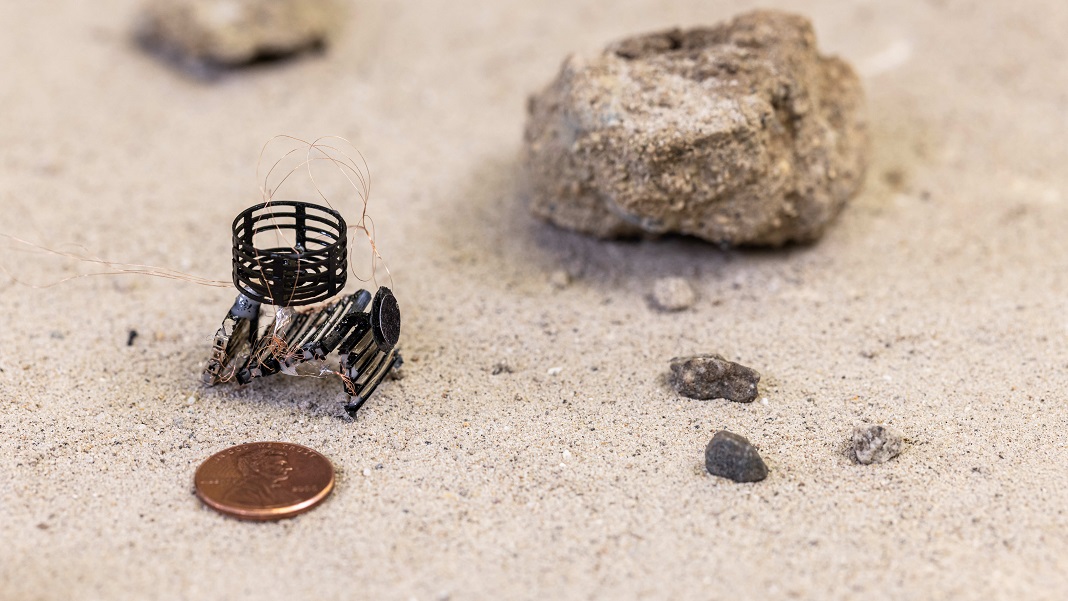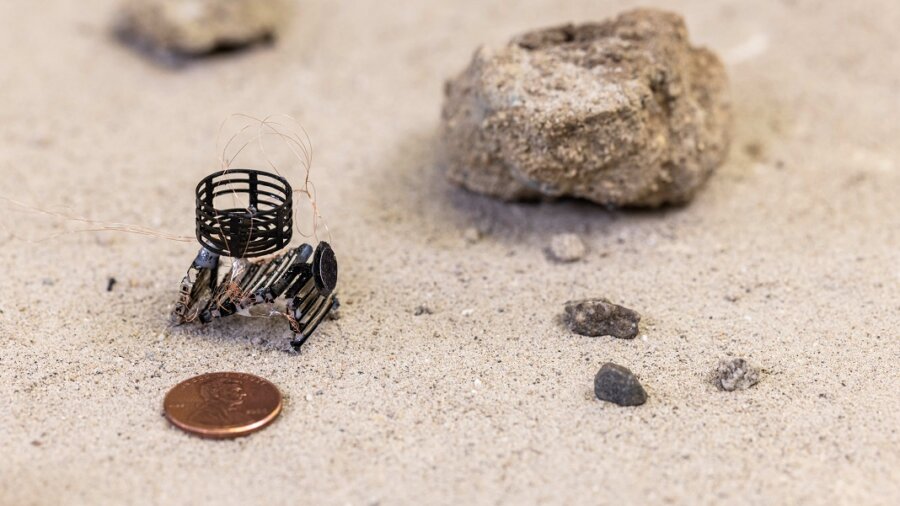

The millirobot looked like an adorable cartoon vehicle as it expertly navigated a complex maze. It’s a strange creature: the bottom resembles a collapsed fence; the top, a colander-like basket. The size of a penny, it seems fragile and utterly unassuming.
But at its core is a potential paradigm shift for building autonomous robots that can sense and respond to its local environment. Unlike classic robots, which are assembled with multiple components, the millirobot is 3D printed with a milky-looking metamaterial that can flexibly change its properties with a few electrical zaps.
Metamaterials sound like something out of a comic book, but the concept is simple. Unlike wood, glass, or other static materials we readily rely on to hold their structure, the metamaterials used in the study—piezoelectric materials—easily change their structure when blasted with an electromagnetic field. This allows the material to twist, contort, shrink, or expand. Map out each movement, and it’s possible to build and steer a robot.
To build the bot, the team designed a 3D printing setup to print out robotic structures using piezoelectric materials. As an additional add-on, the team gave the bots an ultrasound glowup, embedding components into the material, which helped the bots turn vibrations into electricity to sense their environment.
The millibots learned to autonomously walk, jump, and escape from potential obstacles in real time. They could even take a mini-beach hike in the lab, easily navigating through a rough, sandy terrain partially covered with greenery.
The bots, though still rudimentary, could one day help deliver drugs in confined spaces in our bodies if shrunken down. They may also act as cheap, tiny, but powerful scouts to explore new or hazardous environments.
To Dr. Ahmad Rafsanjani at the Center for Soft Robotics, University of Southern Denmark, who was not involved in the study, the millibots bring metamaterials into the limelight as a new way to construct autonomous robots. The study “highlights a broader view of ‘robotic materials’ in which the boundary between materials and machines becomes indiscernible,” he wrote in a related commentary. “Additive manufacturing of piezoelectric metamaterials may lead to materializing fully integrated robots that might eventually walk straight out of a 3D printer.”
Meta-What?
Metamaterials are weird. But thanks to their exotic properties, scientists have readily explored potential uses for these strange ducks. A classic one is optics. Metamaterials are often made of components that flexibly interact with electromagnetic waves, including light. In a way, they’re similar to camera lenses or mirrors, but with the superpower to rapidly change how they direct every light wave. In theory, a carefully created structure from metamaterials could overhaul all types of glasses—from microscope lenses to those on our faces.
More recently, scientists began exploring other uses. One major effort is incorporating piezoelectric materials into neuromorphic chips, which roughly simulate how the brain computes and stores information. By changing the properties of these materials with electrical fields, scientists can approximate how synapses work with ultra-low energy. Other studies tapped into metamaterials’ acrobatic ability to morph their shape, creating structures that convert linear motion—say, a crab walk—into rotations and mechanical gears. It’s as if your legs suddenly turn into rotating wheels.
Yeah, metamaterials are weird. How do they work?
It helps to imagine them as old-school boxed TVs with antennae. To adjust the channel—that is, the material’s behavior—you move the antennae around until their structure interacts strongly with radio waves, and voilá, you’ve nailed the material’s state. It can then be blended with conventional materials to build intricate, lattice-like structures while preserving their metamorphosis properties. This flexibility makes them an especially intriguing canvas for designing robots. Because they’re a near-single structure, in the long run, they could help build intelligent prosthetics less prone to failure, as they don’t have mechanical moving parts. Rather than soldering, they can now be 3D printed. (This gives me all the Westworld vibes—mechanical Dolores versus milky-liquid printed version, anyone?).
Stranger Things
The new millibots look like a hybrid between Wall-E and TARS, a ridged, folding, chopsticks-esque robot in Interstellar. Fully 3D printed, they shattered the conventional dogma for building robots. Normally, a robot needs several independent components: sensors to navigate the environment, microprocessors for the “brain,” actuators for movement, and a power supply to drive the whole system. Each link is prone to failure.
Here, the team integrated each component into one design. The first key ingredient is piezoelectric materials, which convert electrical fields into mechanical tension and vice versa. They’re the “muscles” that guide the robot’s movement. But they do triple duty. Depending on the state of the metamaterial, it can form a ceramic-like backbone to help the millibot maintain its shape. In its conductive phase, it acts like nerve cells, capturing electromagnetic signals to control the “muscles.” Further bumping up the bot’s prowess is an ultrasonic element, melded onto the bot, that helps it sense its surroundings.
Altogether, the simple millibot essentially has multiple systems mixed into one glaring white goo: a nervous system capable of sensing and actuation, a “muscle” component, and a skeletal structure. Dropping the goo into a 3D printer, the team built sophisticated lattices as the robot’s backbone, each carefully decorated with conductive metals and piezoelectric properties onto specific regions.
The result? A tiny robot that taps into electrical fields to sense and navigate its environment. Even more impressive is its ability to “understand” its own bodily movements and place in space—a trick called proprioception that’s been dubbed the “sixth sense” of human perception and rarely implemented in robots.
With a few challenges, the authors next showcased the bots’ prowess. One robot expertly navigated around roadblocks in real time as a human sequentially dropped down barriers based on ultrasound feedback. In another test, the robot hopped long distances and expertly navigated sharp turns. With just milliseconds of delay, the robot frog hopped several rough surfaces without a sweat—a motor task that’s previously bewildered other bots.
The millibots also made great pack mules. Even with 500 percent weight in payload—such as an onboard power source, a driver, and a microcontroller—they were able to move easily with just a 20 percent decline in speed. In practice, the superpower makes these bots great scaffolds as drug delivery machines that may one day roam our bloodstream.
A Ways to Go
A single piece of piezoelectric material can be extremely flexible, with six degrees of freedom—the ability to extend linearly in three axes (like bending your arm forward, sideways, and back) and twist rotationally. Thanks to the study’s additive manufacturing, it’s easy to design different robotic architectures guided by creative algorithms.
The team “artfully interweaved actuation and perception in a lightweight miniature
composite 3D lattice that moves around and senses its surroundings,” said Rafsanjani.
The robots may come off as an incongruous conundrum: a flexible creature that’s made of hard ceramic-like backbone with one metamaterial. But so are we humans—we’re made of cells with vastly different shapes, sizes, and capabilities. Adapting ideas used to design piezoelectric robots gives soft robotics a new outlook, potentially leading to completely artificial materials that jive with our bodies.
The study “brings robotic metamaterials closer to biological systems, one function at a time,” said Rafsanjani.
Image Credit: Rayne Research Group